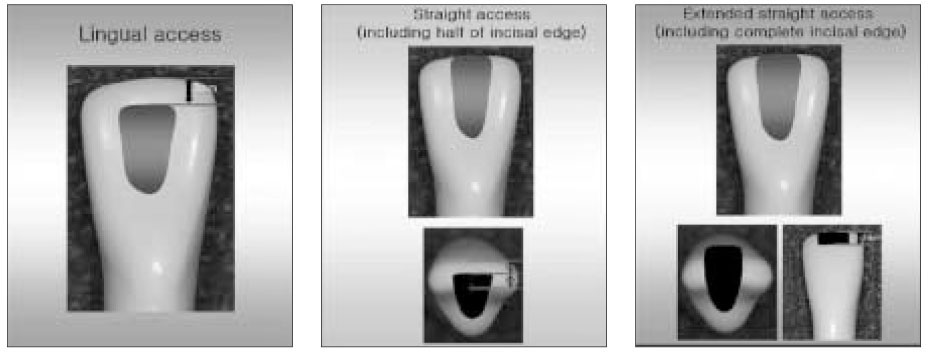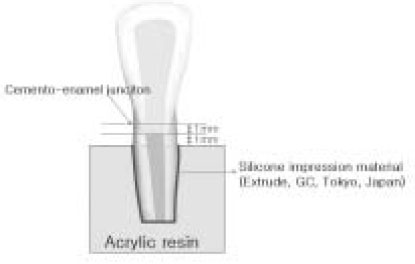Abstract
Straight access cavity design allows the operator to locate all canals, helps in proper cleaning and shaping, ultimately facilitates the obturation of the canal system. However, change in the fracture strength according to the access cavity designs was not clearly demonstrated yet. The purpose of this study was to determine the influence of different access cavity designs on the fracture strength in endodontically treated mandibular anterior teeth.
Recently extracted mandibular anterior teeth that have no caries, cervical abrasion, and fracture were divided into three groups (Group 1 : conventional lingual access cavity, Group 2 : straight access cavity, Group 3 : extended straight access cavity) according to the cavity designs. After conventional endodontic treatment, cavities were filled with resin core material. Compressive loads parallel to the long axis of the teeth were applied at a crosshead speed of 2mm/min until the fracture occurred. The fracture strength analyzed with ANOVA and the Scheffe test at the 95% confidence level.
The results of this study were as follows :
1. The mean fracture strength decrease in following sequence Group 1 (558.90 ± 77.40 N), Group 2 (494.07 ± 123.98 N) and Group 3 (267.33 ± 27.02 N).
2. There was significant difference between Group 3 and other groups (P = 0.00).
Considering advantage of direct access to apical third and results of this study, straight access cavity is recommended for access cavity form of the mandibular anterior teeth.
References
1. Mauger MJ, Waite RM, Alexander JB, Schindler WG. Ideal endodontic access in mandibular incisors. J Endod 1999. 25(3)206–207.
2. Weine FS. Endodontic Therapy 2003. 6th edth ed. St. Louis: Mosby; 104–163.
3. Mannan G, Smallwood ER, Gulabivala K. Effect of access cavity location and design on degree and distribution of instrumented root canal surface in maxillary anterior teeth. Int Endod J 2001. 34(3)176–183.
4. Benjamin KA, Dowson J. Incidence of two root canals in human mandibular incisor. Oral Surg Oral Med Oral Pathol 1974. 38(1)122–126.
5. LaTurno SAL, Zillich RM. Straight-line endodontic access to anterior teeth. Oral Surg Oral Med Oral Pathol 1985. 59(4)418–419.
6. Zillich RM, Jerome JK. Endodontic access to maxillary lateral incisors. Oral Surg Oral Med Oral Pathol 1981. 52(4)443–445.
7. Rhim EM, Choi HY, Park SJ, Choi GW. The canal system of mandibular incisors. J Korean Acad Conserv Dent 2002. 27(4)432–439.
8. Gutmann JL. The dentin-root complex: anatomic and biologic considerations in restoring endodontically treated teeth. J Prosthet Dent 1992. 67(4)458–467.
9. Reeh ES, Messer HH, Douglas WH. Reduction in tooth stiffness as a result of endodontic and restorative procedures. J Endod 1989. 15(11)512–516.
10. Chow TW. Mechanical effectiveness of root canal irrigation. J Endod 1983. 9(11)475–479.
11. Heydecke G, Butz F, Strub JR. Fracture strength and survival rate of endodontically treated maxillary incisors with approximal cavities after restoration with different post and core systems: an in-vitro study. J Dent 2001. 29(6)427–433.
12. Milot P, Stein RS. Root fracture in endodontically treated teeth related to post selection and crown design. J Prosthet Dent 1992. 68(3)428–435.
13. Sorensen JA, Engelman MJ. Ferrule design and fracture resistance of endodontically treated teeth. J Prosthet Dent 1990. 63(5)529–536.
14. Tidmarsh BG. Restoration of endodontically treated posterior teeth. J Endod 1976. 2(12)374–375.
15. Helfer AR, Melnick S, Schilder H. Determination of the moisture content of vital and pulpless teeth. Oral Surg Oral Med Oral Pathol 1972. 34(4)661–670.
16. Papa J, Cain C, Messer HH. Moisture content of vital vs endodontically treated teeth. Endod Dent Traumatol 1994. 10(2)91–93.
17. Rivera EM, Yamauchi M. Site comparisons of dentine collagen cross-links from extracted human teeth. Arch Oral Biol 1993. 38(7)541–546.



